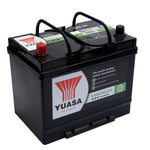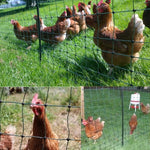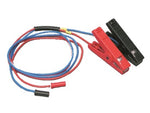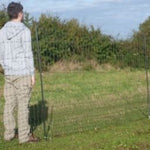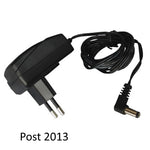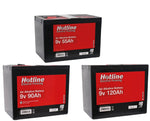You have no items in your shopping cart.
Techniques that will improve the Effectiveness of your Electric Fence
THE ELECTRIC FENCE ENERGISER.
There is an all too real reason to buy an energiser that just meets your requirements due to price considerations. The majority of figures quoted by manufactures' capacity are based on a fence of good quality and in perfect condition, often under laboratory conditions. Unfortunately this will leave you with very little capacity when there is a fault, vegetation growth or increased challenge. If at all possible get an energiser that is larger than required. This will allow you plenty of latitude and it will be able to power through most situations as they arise.
THE EARTH POST.
The ground constitutes 50% of the electrical circuit but 90% of all problems originate at poor earthing, either at the earth stake itself or on the fence. Fortunately this is easy to rectify. Additional earth stakes may be added by driving them into the ground about 2m away from the existing stake and joining them together. Copper, Stainless Steel or Galvanized steel rods are best as mild steel will rust so creating a poor conducting barrier. All rods should be in permanently moist soil, under the building eaves, in a river bed, below a dripping tap or in an irrigated flower bed. In particularly dry weather the soil around the stakes may be watered.If the fence extends over 500m away from the main earth it will be necessary to add an additional earth line to the bottom of the fence and bury a stake at those intervals. Wire is a better conductor than ground so a ground rod every +/- 500meters will greatly increase the effectiveness of the fence.

ELECTRIC FENCING IN A DRY CLIMATE.
In dry climates or where the soil is very sandy resulting in poor conductivity through the soil, it will be necessary to consider an Earth Return fence. This is where the fence is constructed from equal numbers of live and earth wires to remove the ground from the electrical circuit. The animal is required to touch both wires to achieve the desired effect. An earth post is still utilised to cater for current flow through the ground.

INSULATING THE FENCE CONDUCTORS.
The strictest rule applies here - THE WIRES MUST TOUCH NOTHING BUT PLASTIC. It is important that the contact between outside influences be kept to a minimum. Each leaf that touches the fence will draw off a bit of the energy - so one leaf will have no effect but a few thousand will cause the fence to be ineffective. The wires must not be wound around a tree, nailed to wooden posts, tied to a steel stake or any other object (Yes it does occur).
POSITIONING OF THE FENCE WIRES.
The first rule of positioning the wires for a particular target is to realise that all animals utilise their noses to investigate a suspicious object. Therefore the object is to make it easy for the target to investigate a live wire by placing it at the resting height of the nose. It is important that the target is not forced to stretch to investigate the fence and encounters it naturally and easily. Horses are sometimes fitted with blankets. These thick blankets are effective insulators so a second wire must be positioned to miss the blanket. This may be aimed at the knee area below the edge of the blanket so that the knee will make contact with a hot wire when the horse presses forward.
CONNECTING THE WIRES
By connecting all the electrified wires every 30 meters improves the travel of the electrical charge down the lines. Should one of the lines having been broken, it will be reconnected at this point and the WHOLE fence will be re-energised including back to the break. Purpose made wire connectors are best but as long as you ensure a good connection is made then any system may be employed.
BAITING THE FENCE
This is the most effective technique to increase the effectiveness of a fence where an animal that simply ignores the pain or where its natural instinct enables it to evade the fence all together. Here we are referring to Springbok, Impala and some species of Deer. These animals simply walk up to a fence and will simply jump over the fence without investigating it. They can all clear well in excess of 2 meters (6ft) so a substantial fence must be utilised.
By attaching suitable bait to the fence these animals are encouraged to investigate the wires with their nose and tongue that are packed with sensitive nerve endings so the animal will receive a shock that really re-enforces the psychological imprint of the fence. This should only be done in the initial stages and discontinued when they have achieved their desired effect.
There is no point in baiting a fence for an animal that is naturally curious, that will slowly investigate a fence before trying to make an entrance. They will often sense the electricity as being alien and not try the fence or receive an effective shock anyway. It would be cruel to stimulate them to test the fence if they were going to respect it anyway.
QUALITY OF THE CONDUCTORS.
There is only one thing to be considered when looking at tapes, rope or twine to use on an Electric Fence:-The Conductivity (the ability to carry electricity) of the material. An Elephant or horse will not be fenced in by plain rope or tape but apply an electric current and they are easily contained.
The quality of the Electric "sting" delivered to the target is directly dependant on the quality of the conducting material. This is the "barb" that will keep your target animal where you want him. The conductivity of the material is quoted as Ohms per metre or Ohms/m. (this is a measure of the inline resistance). The higher this figure is - the less of the current that is delivered to that important sting. The lower the Ohms/metre is, the more electricity it will carry and deliver an effective sting.
For example:- An energiser capable of energising 9klm with a 0.05 Ohms/m. conductor will be reduced to just 1.3klm if you use a conductor of over 10 Ohms/m. Conversely, when an energiser is used to charge 1.3 klm of fence using a good conductor it will use far less energy than using a poor conductor;- your batteries will last far longer.
Generally the conductivity is reflected in the price of the product. Make sure you know what you are buying. Caveat emptor - let the buyer beware. Copper or Aluminium is by far the best conductor, but generally more expensive. This may be off-set by having more steel conductors but it is important to compare conductivity (however it is delivered) to get the best return per pound spent. A tape with 6-8 conductors may not be as economical as one with 3-5. There are plenty of un-declared products on the market - make sure you know what you are buying. As a general rule, a product with only steel conductors is normally of a lower conductive quality, normally reflected in the price.
The strength of the conductive material is supplied by the plastic strands, not by the thin stainless steel or copper filaments. Rope is stronger than tape as the strands are closely wound and so combine their strength better than tape.
Life of the conductor is determined by wind action and Ultra Violet rays from sunlight breaking down the polyplastic material. Tape has a greater surface area exposed to sunlight and is more affected by wind action. Because of these two constraints the life of tapes may be substantially shorter than rope. The only advantage tape has over rope is its visibility.

